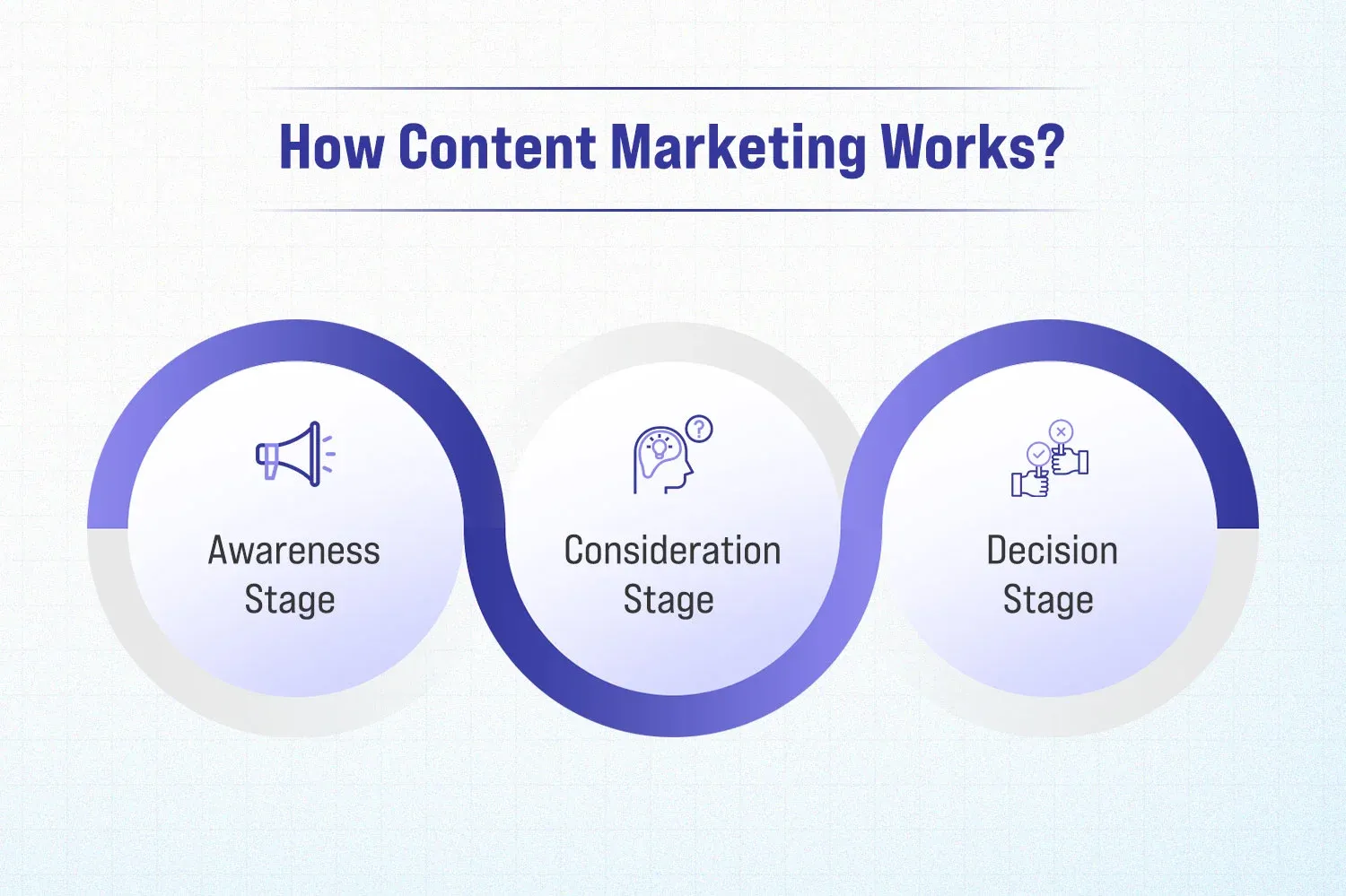What is Content Marketing?

In today’s hyperconnected, information-saturated world, brands must do more than just advertise; they must earn attention that doesn’t interrupt but invites the audience in. This is where content marketing steps in.
Content marketing is a deliberate method centered on crafting and sharing meaningful, timely, and cohesive material to engage a targeted audience with the end goal of inspiring revenue-generating decisions.
Unlike traditional marketing that often interrupts people with ads, content marketing pulls people in by offering them something useful: knowledge, entertainment, insight, or a solution to a problem. For students of management, understanding this methodology is crucial, as it represents a shift in how modern businesses communicate, build trust, and generate long-term value.
How Content Marketing Works?
Content marketing operates as a strategic process that guides potential customers through their decision-making journey using informative, relevant, and engaging content. Instead of pushing direct sales, it nurtures relationships and builds trust by delivering value at each stage of the buyer’s journey. This process typically follows a three-stage funnel:

Awareness Stage
At the top-of-the-funnel (TOFU) stage, the goal is to attract attention and educate potential customers who are just discovering a problem or need. Content here should inform rather than sell.
- Objective: Introduce your brand and offer helpful insights.
- Types of Content: Blog posts, infographics, how-to videos, explainer podcasts, and social media content.
- Tone: Neutral, educational, and audience centric.
Example: A SaaS company might publish a blog titled “5 Common Time Management Challenges Faced by Remote Teams” to resonate with early-stage prospects.
Consideration Stage
Now that your audience is aware of their problem, they begin exploring different solutions. Your content should steer potential customers while presenting your offering as a logical choice.
- Objective: Demonstrate authority, answer deeper questions, and introduce your solutions subtly.
- Types of Content: Case studies, comparison articles, expert webinars, whitepapers, detailed how-to guides.
- Tone: Insightful, credible, and subtly persuasive.
Example: The same SaaS company might release a case study titled “How XYZ Corp improved remote team productivity by 40% using our platform.”
Decision Stage
At the bottom of the funnel (BOFU), leads are nearing their final purchasing decision. Your content should now support the sales process by reinforcing your unique value proposition and removing last-minute doubts.
- Objective: Convert leads into customers.
- Types of Content: Product demos, testimonials, detailed product pages, ROI calculators, buyer’s guides.
- Tone: Confident, value-driven, and reassuring.
Example: A video demo showing how easy it is to onboard new users on the SaaS platform, paired with customer testimonials.
To get the most out of your content marketing strategy, a company must also follow the below steps:
Identify Your Audience
No content strategy succeeds without a profound understanding of the target audience. Begin by developing buyer personas—detailed, research-backed profiles representing your target customers. These personas guide the tone, format, and placement of your content.
Management students should understand that accurate audience segmentation leads to more personalized and effective content, ultimately improving conversion rates.
Determine the Right Formats
Not all content is created equal. Select content styles depending on your audience’s interests and their current stage of the buying process.
- Top of the Funnel (TOFU): Blogs, videos, podcasts, social posts.
- Middle of the Funnel (MOFU): Webinars, how-to guides, infographics.
- Bottom of the Funnel (BOFU): Product demos, case studies, FAQs, live Q&As.
A data-driven understanding of content format performance can help prioritize resource allocation in future campaigns.
Determine How You’ll Distribute
Producing excellent content is just part of the process; effective distribution ensures it reaches the intended audience.
- Owned Media: Company website, blog, email newsletter.
- Earned Media: Guest posts, influencer mentions, media coverage.
- Paid Media: Sponsored content, pay-per-click (PPC) ads, social media ads.
An effective strategy blends these channels to create a cohesive customer experience across platforms.
Choose a Sustainable Schedule
Consistency is key in content marketing. Establish a publishing calendar based on your team’s bandwidth and your audience’s expectations.
- Weekly blog posts.
- Monthly email newsletters.
- Quarterly eBooks or whitepapers.
Use editorial calendars and content management tools to stay organized and ensure steady engagement.
Follow Best Practices
To maximize results, your content marketing should follow these core best practices:
Focus on value, not promotion: Educate and inform rather than sell directly.
- Use SEO wisely: Optimize search engines to increase organic reach.
- Repurpose existing content: Transform in-depth material into shorter formats for social media or email outreach.
- Track performance: Analyze metrics like visitor numbers, engagement duration, and conversion rates to optimize strategy.
The Benefits of Content Marketing
Content marketing delivers a wide range of strategic benefits that go far beyond simple brand awareness:
- Builds Trust and Brand Credibility: One of the most powerful outcomes of content marketing is trust. By consistently delivering helpful, relevant, and high-quality content, brands position themselves as reliable sources of information. Consistently executing this strategy establishes the brand as a knowledgeable authority in its field.
- Supports the Entire Buyer Journey: Unlike traditional advertising, which often focuses only on conversion, content marketing nurtures customers throughout their journey—from awareness to decision.
- Improves Organic Search Visibility (SEO): Quality content optimized for search engines helps businesses appear in relevant search results, increasing discoverability without the ongoing costs of paid ads. Strategic use of keywords, backlinks, and structured content enhances SEO performance and drives sustainable traffic.
- Increases Engagement and Customer Retention: Valuable content doesn’t just attract; it keeps audiences engaged. Whether through blog series, interactive webinars, or email newsletters, ongoing content helps maintain a relationship with customers even after a sale, encouraging brand loyalty and repeat business.
- Enhances Lead Generation and Conversion Rates: Content marketing draws in prospects with useful information rather than intrusive ads. When paired with lead magnets like eBooks, templates, or webinars, it becomes a powerful mechanism for capturing contact information and nurturing leads toward conversion.
- Reduces Customer Acquisition Costs: Content marketing proves far more economical than conventional ads in the long run. While it may require upfront investment, its ongoing value, especially evergreen content, continues to generate traffic and leads long after publication.
Why Use Content Marketing?
As digital platforms evolve, customers are no longer persuaded by intrusive ads. Instead, they’re looking for values like helpful information, relevant insights, and authentic connections. Content marketing delivers exactly that while also supporting and enhancing other essential areas of your marketing ecosystem.
Here’s how content marketing strengthens various marketing disciplines and helps businesses grow:
Social Media Marketing
Content marketing powers social media by providing a steady stream of engaging, shareable material tailored to your audience’s interests. Social media platforms thrive on fresh content like educational blog snippets, entertaining short videos, or striking visuals from infographics.
Why it matters: Without quality content, social media marketing becomes a series of empty promotions. With it, brands can spark conversations, build community, and encourage organic sharing.
Search Engine Optimization (SEO)
Search engines favor sites that provide up-to-date, meaningful, and keyword-optimized content. Regularly publishing high-quality content like blog posts, guides, or videos improves a site’s authority and helps it rank higher in search results.
Why it matters: Effective SEO drives organic (unpaid) traffic to your website, and content is the fuel that powers it. A content-rich site is more likely to capture attention during critical customer search moments.
Public Relations (PR)
Modern PR relies on storytelling—and content marketing is how you tell those stories. Whether introducing a new offering, managing a crisis, or showcasing leadership expertise, polished content enhances brand reputation.
Why it matters: PR without content lacks substance. Great content helps control narratives, build credibility, and attract media interest organically.
Pay-Per-Click Advertising (PPC)
While PPC focuses on driving immediate traffic through paid placements, content marketing enhances PPC by improving landing page relevance and increasing conversion rates. Compelling content encourages visitors to stay, explore, and take action.
Why it matters: Effective PPC doesn’t end with a click. Content ensures that what users see after the ad encourages deeper engagement and justifies the ad spend.
Inbound Marketing
Inbound marketing draws customers by delivering value and solving problems—not through aggressive sales tactics. Content marketing is the primary way to execute this strategy. From informative blog posts to downloadable whitepapers, content draws potential buyers in naturally.
Why it matters: Inbound marketing focuses on gaining organic interest rather than demanding it. Content marketing creates educational and helpful materials that make this approach work.
Digital Marketing
Digital marketing process covers all online initiatives—spanning websites, apps, email, and social platforms. Content marketing provides the material that powers those channels. It’s what people consume, engage with, and respond to.
Why it matters: Without content, digital marketing is just delivery mechanisms. Content gives it purpose, message, and meaning.
Content Strategy
Content strategy defines the "why," "how," and "for whom" of your content. It guarantees that every piece of content supports company goals, resonates with the audience, and stays true to brand voice.
Why it matters: A strong content strategy transforms marketing from random acts of publishing into a cohesive, goal-driven plan. It ensures resources are invested in content that yields measurable outcomes.
What Are Some Examples of Brands Using Content Marketing?
Top-performing brands go beyond content—they foster engagement, dialogue, and communities that amplify their presence. Here are standout examples of how brands across industries leverage content marketing with strategic impact:

Red Bull
Red Bull has redefined content marketing by positioning itself as a media powerhouse. Through Red Bull Media House, it produces extreme sports videos, documentaries, and live events that align with its brand ethos of “giving wings.” From cliff diving competitions to Formula 1 coverage, Red Bull’s content inspires an entire lifestyle and subtly reinforces its product as part of that experience.
HubSpot
HubSpot, a B2B marketing and sales software company, built its brand by providing free educational content, including blogs, certifications, templates, and webinars. Its HubSpot Academy teaches inbound marketing to millions, making the brand a trusted resource before it ever pitches its product.
Nike
Nike uses emotionally charged video content and social media campaigns to tell stories that go beyond sports. Campaigns like “You Can’t Stop Us” and partnerships with athletes like Serena Williams and Colin Kaepernick demonstrate how Nike leverages storytelling to connect deeply with values like perseverance, equality, and empowerment.
LEGO
LEGO’s content strategy centers on creativity and user engagement. Through LEGO Ideas, fans submit their own designs, which can be turned into real products. LEGO also runs video series, comic books, games, and even a blockbuster movie franchise—all reinforcing the brand’s playful innovation.
Glossier
Glossier, a beauty brand, grew its dominance through customer-created content and community-focused strategies. It encourages everyday customers to share product tips and photos on social media, turning loyal users into authentic brand ambassadors. Its blog, “Into the Gloss,” offers beauty advice and stories from real people, enhancing relatability.
FAQs
Q1. What is content marketing in digital marketing?
Ans: Content marketing in digital marketing involves crafting and sharing meaningful, targeted content to attract and retain a specific audience, driving revenue-generating actions.
It’s a foundational part of digital marketing that focuses on delivering information and storytelling across channels like blogs, social media, video, email, and more rather than pushing direct sales messages. When executed effectively, it cultivates credibility, expertise, and lasting connections.
Q2. What is the primary goal of content marketing?
Ans: The primary goal of content marketing is to build trust and provide value at every stage of the customer journey — from awareness to decision. Rather than aggressively selling, it aims to educate, engage, and nurture potential customers until they are ready to buy, while also strengthening brand loyalty and customer retention post-purchase.
Summing Up
Content marketing is no longer optional—it's essential for any brand seeking to build meaningful, long-term relationships in the digital age. It offers a smarter, more human approach to engaging with audiences by focusing on value rather than volume, storytelling instead of selling, and trust over tactics.
For management students, mastering content marketing means understanding the evolving nature of consumer behavior and the strategic role content plays in every touchpoint of the buyer’s journey. Whether through blogs, videos, social media, or email, content marketing helps organizations inform, inspire, and influence their audience while supporting broader business goals like lead generation, customer retention, and brand loyalty.





